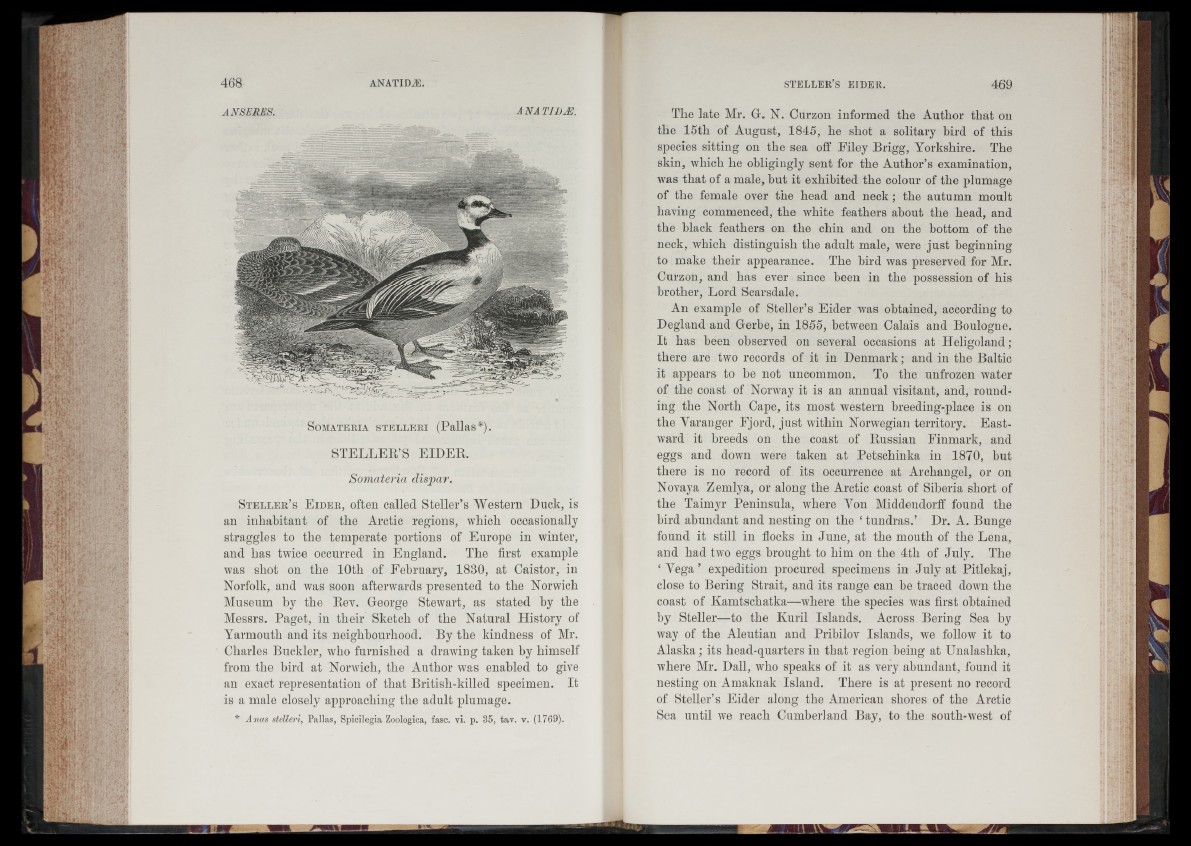
SoMATERIA STELLERI (Pallas*).
STELLER’S EIDER.
Somateria dispar.
Steller’s E ider, often called Steller’s Western Duck, is
an inhabitant of the Arctic regions, which occasionally
straggles to the temperate portions of Europe in winter,
and has twice occurred in England. The first example
was shot on the 10th of February, 1830, at Caistor, in
Norfolk, and was soon afterwards presented to the Norwich
Museum by the Rev. George Stewart, as stated by the
Messrs. Paget, in their Sketch of the Natural History of
Yarmouth and its neighbourhood. By the kindness of Mr.
Charles Buckler, who furnished a drawing taken by himself
from the bird at Norwich, the Author was enabled to give
an exact representation of that British-killed specimen. It
is a male closely approaching the adult plumage.
* Arias stelleri, Pallas, Spicilegia Zoologica, fasc. vi. p. 35, tav. v. (1769).
The late Mr. G. N. Curzon informed the Author that on
the 15tli of August, 1845, he shot a solitary bird of this
species sitting on the sea off Filey Brigg, Yorkshire. The
skin, which he obligingly sent for the Author’s examination,
was that of a male, but it exhibited the colour of the plumage
of the female over the head and neck; the autumn moult
having commenced, the white feathers about the head, and
the black feathers on the chin and on the bottom of the
neck, which distinguish the adult male, were just beginning
to make their appearance. The bird was preserved for Mr.
Curzon, and has ever since been in the possession of his
brother, Lord Scarsdale.
An example of Steller’s Eider was obtained, according to
Degland and Gerbe, in 1855, between Calais and Boulogne.
It has been observed on several occasions at Heligoland;
there are two records of it in Denmark; and in the Baltic
it appears to be not uncommon. To the unfrozen water
of the coast of Norway it is an annual visitant, and, rounding
the North Cape, its most western breeding-place is on
the Varanger Fjord, just within Norwegian territory. Eastward
it breeds on the coast of Russian Finmark, and
eggs and down were taken at Petschinka in 1870, but
there is no record of its occurrence at Archangel, or on
Novaya Zemlya, or along the Arctic coast of Siberia short of
the Taimyr Peninsula, where Yon Middendorff found the
bird abundant and nesting on the ‘ tundras.’ Dr. A. Bunge
found it still in flocks in June, at the mouth of the Lena,
and had two eggs brought to him on the 4th of July. The
‘ Yega ’ expedition procured specimens in July at Pitlekaj,
close to Bering Strait, and its range can be traced down the
coast of Kamtschatka—where the species was first obtained
by Steller—to the Kuril Islands. Across Bering Sea by
way of the Aleutian and Pribilov Islands, we follow it to
Alaska; its head-quarters in that region being at Unalashka,
where Mr. Dali, who speaks of it as very abundant, found it
nesting on Amaknak Island. There is at present no record
of Steller’s Eider along the American shores of the Arctic
Sea until we reach Cumberland Bay, to the south-west of